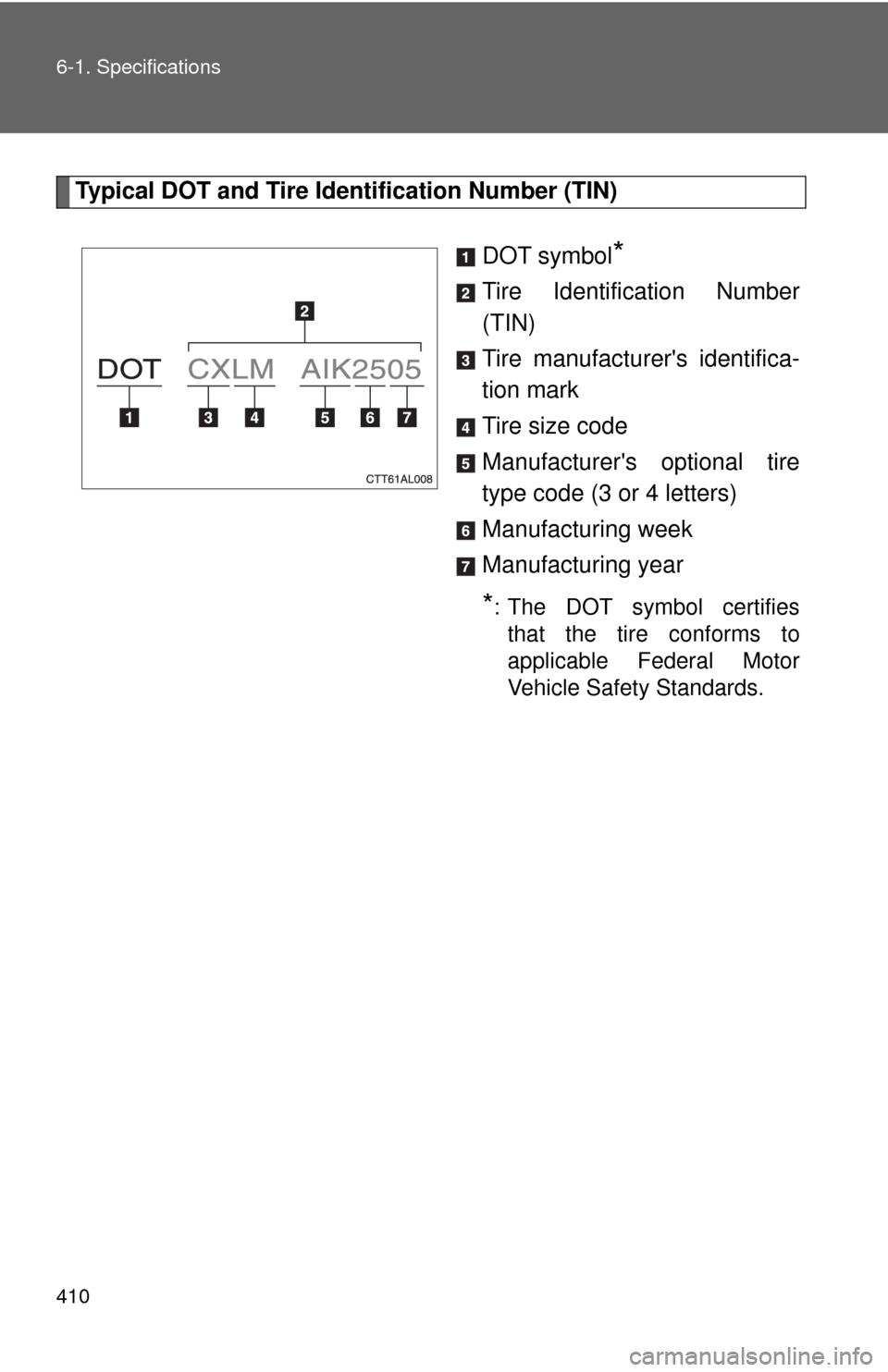TOYOTA MATRIX 2009 E140 / 2.G Owners Manual
Manufacturer: TOYOTA, Model Year: 2009, Model line: MATRIX, Model: TOYOTA MATRIX 2009 E140 / 2.GPages: 440, PDF Size: 9.39 MB
Page 401 of 440

401 6-1. Specifications
6
Vehicle specifications
Type C
Type D
Tire size P205/55R16 89H, T135/70R17 102M
Tire inflation pressure
(Recommended cold tire
inflation pressure)2WD models
Front: 32 psi (220 kPa, 2.2 kgf/cm
2 or
bar)
Rear: 32 psi (220 kPa, 2.2 kgf/cm
2 or
bar)
Spare: 60 psi (420 kPa, 4.2 kgf/cm
2 or
bar)
AWD models
Front: 35 psi (240 kPa, 2.4 kgf/cm
2 or
bar)
Rear: 32 psi (220 kPa, 2.2 kgf/cm
2 or
bar)
Spare: 60 psi (420 kPa, 4.2 kgf/cm
2 or
bar)
Wheel size 16 × 6 1/2 J, 17 × 4T (compact spare)
Wheel nut torque 76 ft•lbf (103 N•m, 10.5 kgf•m)
Tire size P215/45R17 87W, T135/70R16 100M
Tire inflation pressure
(Recommended cold tire
inflation pressure)Front: 32 psi (220 kPa, 2.2 kgf/cm2 or bar)
Rear: 32 psi (220 kPa, 2.2 kgf/cm2 or bar)
Spare: 60 psi (420 kPa, 4.2 kgf/cm2 or bar)
Wheel size 17 × 7J, 16 × 4T (compact spare)
Wheel nut torque 76 ft•lbf (103 N•m, 10.5 kgf•m)
Page 402 of 440

402 6-1. Specifications
Type E
Type F
Tire size P215/45R17 87W, T135/80R16 101M
Tire inflation pressure
(Recommended cold tire
inflation pressure)Front: 32 psi (220 kPa, 2.2 kgf/cm2 or bar)
Rear: 32 psi (220 kPa, 2.2 kgf/cm2 or bar)
Spare: 60 psi (420 kPa, 4.2 kgf/cm2 or bar)
Wheel size 17 × 7 J, 16 × 4T (compact spare)
Wheel nut torque 76 ft•lbf (103 N•m, 10.5 kgf•m)
Tire size P215/45R17 87W, T135/70R17 102M
Tire inflation pressure
(Recommended cold tire
inflation pressure)2WD models
Front: 32 psi (220 kPa, 2.2 kgf/cm
2 or
bar)
Rear: 32 psi (220 kPa, 2.2 kgf/cm
2 or
bar)
Spare: 60 psi (420 kPa, 4.2 kgf/cm
2 or
bar)
AWD models
Front: 35 psi (240 kPa, 2.4 kgf/cm
2 or
bar)
Rear: 32 psi (220 kPa, 2.2 kgf/cm
2 or
bar)
Spare: 60 psi (420 kPa, 4.2 kgf/cm
2 or
bar)
Wheel size 17 × 7 J, 17× 4T (compact spare)
Wheel nut torque 76 ft•lbf (103 N•m, 10.5 kgf•m)
Page 403 of 440

403 6-1. Specifications
6
Vehicle specifications
Type G
Tire size P215/45R18 89W, T135/70R17 102M
Tire inflation pressure
(Recommended cold tire
inflation pressure)Front: 32 psi (220 kPa, 2.2 kgf/cm2 or bar)
Rear: 32 psi (220 kPa, 2.2 kgf/cm2 or bar)
Spare: 60 psi (420 kPa, 4.2 kgf/cm2 or bar)
Wheel size 18 × 7 J, 17 × 4T (compact spare)
Wheel nut torque 76 ft•lbf (103 N•m, 10.5 kgf•m)
Page 404 of 440

404 6-1. Specifications
Light bulbs
A: H11 halogen bulbs B: HB3 halogen bulbs
C: Wedge base bulbs (clear) D: Wedge base bulbs (amber)
E: Double end bulbs F: HB4 halogen bulbs
Light BulbsBulb No.WTy p e
ExteriorHeadlights
Low beam
High beam9006
900551
60F
B
Front turn signal/park-
ing and front side
marker lights3457NA 27/7 D
Front fog lights (if
equipped)⎯55 A
Rear turn signal lights⎯21 D
Stop/tail and rear side
marker lights 7443 21/5 C
License plate lights⎯5C
Back-up lights 921 16 C
InteriorPersonal lights⎯8C
Interior light⎯8E
Page 405 of 440

405
6-1. Specifications
6
Vehicle specifications
Fuel information
■Fuel tank opening for unleaded gasoline
To help prevent incorrect fueling, your Toyota has a fuel tank opening that
only accommodates the special nozzle on unleaded fuel pumps.
■If your engine knocks
●Consult your Toyota dealer.
●You may occasionally notice light knocking for a short time while acceler-
ating or driving uphill. This is normal and there is no need for concern.
■Gasoline quality
In very few cases, driveability problems may be caused by the brand of gas-
oline you are using. If driveability problems persist, try changing the brand of
gasoline. If this does not correct the problem, consult your Toyota dealer.
■Gasoline quality standards
●Automotive manufacturers in the U.S., the Europe and Japan have
developed a specification for fuel quality called World-Wide Fuel Charter
(WWFC) that is expected to be applied worldwide.
●The WWFC consists of four categories that are based on required emis-
sion levels. In the U.S., category 4 has been adopted.
●The WWFC improves air quality by lowering emissions in vehicle fleets,
and improves customer satisfaction through better performance.
You must only use unleaded gasoline in your vehicle.
Unleaded gasoline with an Octane Rating of 87 (Research Octane
Number 91) or higher is required for optimum engine performance.
At minimum, the gasoline you use should meet the specifications
of ASTM D4814 in the U.S.A. and CGSB3.5-M93 in Canada.
Page 406 of 440

406 6-1. Specifications
■Toyota recommends the use of gasoline containing detergent additives
●Toyota recommends the use of gasoline that contains detergent additives
to avoid build-up of engine deposits.
●All gasoline sold in the U.S. contains detergent additives to clean and/or
keep clean intake systems.
■Toyota recommends the use of cleaner burning gasoline
Cleaner burning gasoline, including reformulated gasoline that contains oxy-
genates such as ethanol or MTBE (Methyl Tertiary Butyl Ether) is available in
many areas.
Toyota recommends the use of cleaner burning gasoline and appropriately
blended reformulated gasoline. These types of gasoline provide excellent
vehicle performance, reduce vehicle emissions and improve air quality.
■Toyota does not recommend blended gasoline
●Toyota allows the use of oxygenate blended gasoline where the oxygen-
ate content is up to 10% ethanol or 15% MTBE.
●If you use gasohol in your Toyota, be sure that it has an octane rating no
lower than 87.
●Toyota does not recommend the use of gasoline containing methanol.
■Toyota does not recommend gasoline containing MMT
Some gasoline contains octane enhancing additive called MMT (Methylcy-
clopentadienyl Manganese Tricarbonyl).
Toyota does not recommend the use of gasoline that contains MMT. If fuel
containing MMT is used, your emission control system may be adversely
affected.
The malfunction indicator lamp on the instrument cluster may come on. If
this happens, contact your Toyota dealer for service.
Page 407 of 440

407 6-1. Specifications
6
Vehicle specifications
NOTICE
■Notice on gasoline quality
●Do not use leaded gasoline.
Leaded gasoline can cause damage to your vehicle’s catalytic converters
causing the emission control system to malfunction.
●Do not use gasohol other than that stated here.
Other gasohol may cause fuel system damage or vehicle performance
problems.
■Fuel-related poor driveability
If after using a different type of fuel, poor driveability is encountered (poor
hot starting, vaporization, engine knocking, etc.), discontinue the use of that
type of fuel.
■When refueling with gasohol
Take care not to spill gasohol. It can damage your vehicle's paint.
Page 408 of 440

408
6-1. Specifications
Tire information
Typical tire symbols
Full-size tire
Compact spare tire
Tire size (→P. 411)
DOT and Tire Identification Number (TIN) (→P. 410)
Uniform tire quality grading
For details, see “Uniform Tire Quality Grading” that follows.
Location of treadwear indicators (→P. 303)
Page 409 of 440

409 6-1. Specifications
6
Vehicle specifications
Tire ply composition and materials
Plies are layers of rubber-coated parallel cords. Cords are the
strands which form the plies in a tire.
Radial tires or bias-ply tires
A radial tire has “RADIAL” on the sidewall. A tire not marked
“RADIAL” is a bias-ply tire.
TUBELESS or TUBE TYPE
A tubeless tire does not have a tube and air is directly filled in the
tire. A tube type tire has a tube inside the tire and the tube main-
tains the air pressure.
Load limit at maximum cold tire inflation pressure (→P. 307)
Maximum cold tire inflation pressure (→P. 400)
This means the pressure to which a tire may be inflated.
Summer tires or all season tires (→P. 308)
An all season tire has “M+S” on the sidewall. A tire not marked
“M+S” is a summer tire.
“TEMPORARY USE ONLY” (→P. 371)
A compact spare tire is identified by the phrase “TEMPORARY USE
ONLY” molded into its sidewall. This tire is designed for temporary
emergency use only.
Page 410 of 440

410 6-1. Specifications
Typical DOT and Tire Identification Number (TIN)
DOT symbol
*
Tire Identification Number
(TIN)
Tire manufacturer's identifica-
tion mark
Tire size code
Manufacturer's optional tire
type code (3 or 4 letters)
Manufacturing week
Manufacturing year
*: The DOT symbol certifies
that the tire conforms to
applicable Federal Motor
Vehicle Safety Standards.